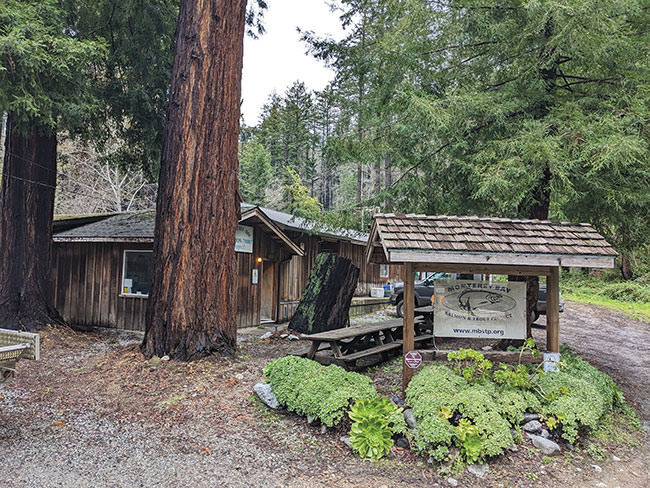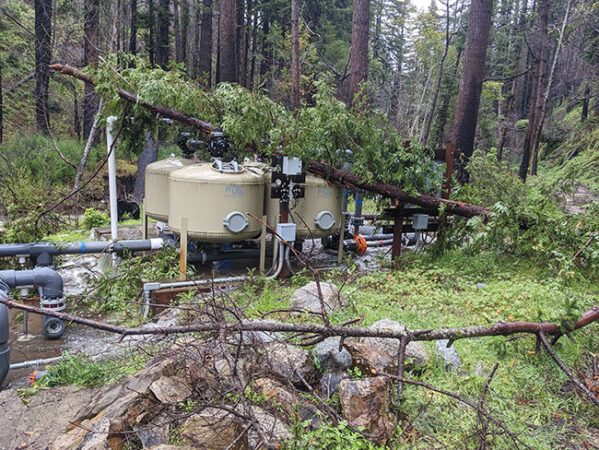
Features
Hatchery Operations
Systems management
California hatcheries brace from this year’s storm season
April 13, 2023 By Julia Hollister
 Kinfisher Flat hatchery contines its work as staff contend with extreme weather.
Photos: Monteray Bay Salmon and trout project
Kinfisher Flat hatchery contines its work as staff contend with extreme weather.
Photos: Monteray Bay Salmon and trout project The storm signs were all over: darkening clouds, chilly winds and then the rains came with fierce force.
“Rain started really picking up around the 3rd and 4th of January and the storm and was pretty non-stop for about three weeks,” said Connor Greenwood, at the Monterey Bay Salmon and Trout Project (MBSTP). “No more damage at the hatchery today (March 14)… But, water is high and wind is bringing down trees in our valley so if anything happens, you’ll be one of the first to know.”
The primary hatchery, Kingfisher Flat, is located on Swanton Road, about 20 minutes north of Santa Cruz, Calif. The genetic conservation, non-profit hatchery was founded in 1976, but the hatchery was opened in 1982. The facility is critical to the recovery of local, native salmonids, namely federally endangered Central California coast Coho salmon and threatened steelhead of Monterey Bay.
In February, the hatchery helped release over 360,000 juvenile Chinook salmon to Monterey Bay. These fish are released at coastal sites to give them a better chance of survival.
Fish produced at Kingfisher Flat facility are of the highest genetic diversity and are the offspring of locally-sourced broodstock. This practice is representative of MBSTP’s efforts to recover native salmon and trout populations of the greater Monterey Bay region while preserving local genetic resources and supporting, rather than impacting, wild populations.
The hatchery is in an ideal setting for a small-scale conservation and recovery hatchery, although this location also comes with some challenges. The hatchery has experienced intense flooding, drought and substantial wildfires in the Big Creek watershed, and has withstood them all.
“Luckily our fish were not affected too badly with the 2023 storm,” Greenwood said. “We lost flow from our main water intake once or twice due to debris or sediment blockages, but our systems are partially recirculating via pumps on a backup generator, so dissolved oxygen never dipped too low.
“Turbidity also caused some stress, but losses were minimal. We were stressed because we couldn’t see the fish and didn’t know how they were doing until the water cleared up about a month later.”
Greenwood said was “all hands on deck during the storm.” The hatchery had multiple people on site every day for the duration of the storms to monitor conditions, maintain systems, clean up the facilities, and clear up log jams to avoid flooding. But with a staff of just two, it was a rough stretch.
Once or twice they were forced to leave the hatchery due to a large amount of treefalls in the valley. They had to carpool in the company truck because their personal vehicles couldn’t cross the pond that formed on Swanton Road on the way into the hatchery.

A tree has fallen on its filtration systems after a recent storm
Dennis Taylor, with the Monterey Herald, reported that in a recent report by District Environmental Resources Manager Thomas Christensen and District Engineer Larry Hampson, the damage to the facility from last month’s flooding is estimated to be about US$250,000. The emergency funding will come out of a reserve account and the district will later seek reimbursement from state and federal agencies as well as insurance.
The storms presented no new problems for Mount Shasta Hatchery in the northern part of California because the area is used to snow. The ‘tons’ of snow cooled the water a little but the fish aren’t bothered. The main problem is trying to keep the roads cleared.
In Santa Cruz, public workers are refilling sand bags and hoping summer comes soon.
“We are aware of the oncoming storms,” said Hatchery Program Manager Kenneth Kundarje with the California Fish and Wildlife. “We experienced no major damage in the recent storms but every hatchery has emergency plans in place to make sure what do when an emergency arises.
“We are keeping an eye on flooding and other situations. These precautions are especially important considering the average age of California hatcheries is 78 years.”
The Monterey Peninsula Water Management district resource manager, Thomas Christensen, heads the mitigation project on the Caramel River that rescues young steelheads when the pools dry in summer. The fish are transported to a rearing facility upstream in the river where the fish are kept all summer. The program came online in 1996.
“The steelheads are reared at the Sleepy Hollow facility located along Carmel River,” he said.
When the river flows again, the fish are released back into the river and hopefully, migrate to the ocean and return to spawn in spring. This is a unique program that is funded by local people who pay their water bills. There is no salmon fishing allowed because they are threatened species, with a short season for catch and release only.
“With the threat of recent storms, we were lucky that we got them out before storms came in,” he said.
Print this page
Advertisement
- BioMar releases new bioremediation solution
- Maine research centre to provide sea scallop spat for local farmers





